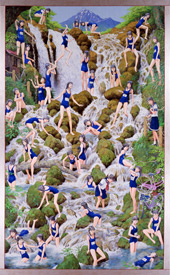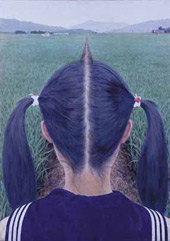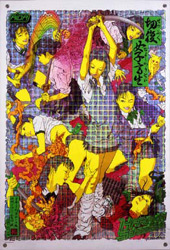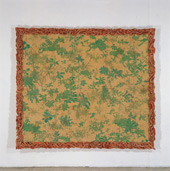Contemporary art in Japan
Harakiri hellraiser
An enfant terrible of Japanese art comes out of the shadows
TOKYO | from the print edition
 The painter and the line of duty
The painter and the line of duty
MAKOTO AIDA’S first retrospective is 250 metres above ground in the Mori Art Museum, on top of one of Tokyo’s swankiest skyscrapers. But there is nothing rarefied about the collection itself. Part of its charm is that it appears to have poured out of what the artist calls his “skewed” mind in a cascade of impish disorder.
There are doe-eyed girls in various states of undress, smiling and languishingly carefree. It takes a moment to realise that the one winking mischievously in “Harakiri School Girls” is disembowelling herself with a samurai sword. Or that the frolicking nudes in his latest (unfinished) work—spread over a large wall—are being blown to bits by a gun, their insides spilling out in a puff of flowers, strawberries and diamonds.
Some work, which gently parodies Japanese masterpieces, reveals what a deft and meticulous painter he is. To some, his video impersonation of a drunken Osama bin Laden claiming to have found peace at last in a Japanese izakaya, or pub, is just plain funny.It is hard to tell whether “War Picture Returns”—a homage to the disgraced second world war artists who did their jobs of glorifying Japan’s war machine all too well—is pro- or anti-war. Mr Aida insists there is nothing political about works such as “A Picture of an Air Raid on New York City”, which shows Japanese “Zero” fighters in an infinity formation flying over a flaming Manhattan. It came, he says, from a mind overcrowded with images after watching too many war films.
But perhaps most intriguing is that the 47-year-old’s exhibition is taking place at all. His contemporary, Takashi Murakami, has recommended that any Japanese contemporary artist who wants to become rich and famous should make it outside Japan first, in order to be accepted at home. Mr Aida has not followed Mr Murakami’s advice. He has only rarely lived abroad; some of his drollest work mocks the difficulty of speaking English (“Stop Speaking with Trilled Rs”, he complains). He makes paintings that he admits are often too erotic for public museums, too grotesque for people’s living rooms and too laced with a Lolita complex for non-Japanese tastes.
He says he never thinks of collectors. One piece, “How to Become the World’s Greatest Artist”, could be a sly dig at Mr Murakami’s celebrated commercialism. The work recommends greeting art-world big shots with “Eh? What’s your name again?” Even better, it says, “go ahead and punch them for no reason whatsoever.”
Yet recognition is starting to creep up on Mr Aida—in Japan at least, if not in the West. He, too, seems to be adapting in middle age to the sensitivities of the market. A room in the exhibition containing his most risqué manga, paintings and video is sealed off, like a peep show, from under 18-year-olds. He admits he is toning down the eroticism in some of his larger works so that they can hang in public museums. He will, however, continue to portray “pretty young girls”, he insists. Not only does he find them the most fun to paint; they also represent what he calls the emasculation of Japan’s male society after its wartime defeat.
But Mr Aida will face an uphill struggle for public approval. One of his admiring critics, Akira Tatehata, president of the Kyoto City University of Art, says the artist is still too “dangerous” for the general public—though his brand of eccentricity should be encouraged. Some in Japan wonder why Mori, a company with annual sales of $2 billion and that builds skyscrapers for the uptown elite, should promote such a downtown hellraiser as Mr Aida or indeed those other iconoclastic Asian artists, China’s Ai Weiwei and South Korea’s Lee Bul. That it does is just another of the incongruities of this exhibition.
The Giant Member Fuji versus King Gidora; Takahashi collection, Tokyo.
Courtesy: Mizuma Art Gallery
Courtesy: Mizuma Art Gallery
Latest information and updates on the artist Aida Makoto, his activities and his solo exhibition at the Mori Art Museum, Tokyo.
About the Exhibition

Picture of Waterfall
2007-10
Collection: The National Museum of Art, Osaka
Courtesy: Mizuma Art Gallery
2007-10
Collection: The National Museum of Art, Osaka
Courtesy: Mizuma Art Gallery

A Picture of an Air Raid on New York City(War Picture Returns)
1996
CG of Zero fighters created by Matsuhashi Mutsuo
TAKAHASHI Collection, Tokyo
Courtesy: Mizuma Art Gallery
1996
CG of Zero fighters created by Matsuhashi Mutsuo
TAKAHASHI Collection, Tokyo
Courtesy: Mizuma Art Gallery

AZEMICHI (a path between rice fields)
1991
Collection: Toyota Municipal Museum of Art, Aichi
Courtesy: Mizuma Art Gallery
1991
Collection: Toyota Municipal Museum of Art, Aichi
Courtesy: Mizuma Art Gallery
AIDA MAKOTO, UNVEILED GENIUS IN CHAOS!
Aida Makoto is one of the most noted contemporary artists in Japan today. Though grotesque and erotic in style, Aida's work displays an incisive critical faculty when it comes to political and historical issues.
And, while projecting modern Japanese society, he simultaneously draws heavily on traditional artworks and modes of expression. It is also true, however, that surveying Aida's oeuvre, that very ambiguity starts to resemble a miniature version of Japanese society. This exhibition, Aida Makoto's first solo museum show, will reveal the artist in all his chaotic glory, via around 100 works - including new offerings - covering the two decades since his arrival on the international art scene.
And, while projecting modern Japanese society, he simultaneously draws heavily on traditional artworks and modes of expression. It is also true, however, that surveying Aida's oeuvre, that very ambiguity starts to resemble a miniature version of Japanese society. This exhibition, Aida Makoto's first solo museum show, will reveal the artist in all his chaotic glory, via around 100 works - including new offerings - covering the two decades since his arrival on the international art scene.
| Exhibition Period: | November 17 (Sat), 2012 – March 31 (Sun), 2013 >>Open Hours |
|---|---|
| Venue: | Mori Art Museum 53F Roppongi Hills Mori Tower |
| Organizer: | Mori Art Museum |
| Curated by: | Kataoka Mami (Chief Curator, Mori Art Museum) |
| Corporate Sponsors: | OBAYASHI CORPORATION SANKEN SETSUBI KOGYO CO.,LTD. SHINRYO CORPORATION KYUDENKO |
| Special Support: | Aida Makoto: Heisei Kanjin Project >>List of Supporters >>Supporter's Messages |
| Support: | Mizuma Art Gallery Champagne Nicolas Feuillatte BOMBAY SAPPHIRE |
| Media Partner: | niconico |
This exhibition contains works with provocative and sexually explicit content. These works reflect diverse aspects of contemporary society in Japan. However, please be warned if you find subject matter of this nature disturbing. The sexually explicit works are displayed in especially designated room and these are marked as being suitable for 18 years old or older only.

Harakiri School Girls
2002
Collection: Watai Yasuyuki
Courtesy: Mizuma Art Gallery
2002
Collection: Watai Yasuyuki
Courtesy: Mizuma Art Gallery

Ash Color Mountains
2009-11
Taguchi Art Collection
Cooperation: Watanabe Atsushi
Courtesy: Mizuma Art Gallery
2009-11
Taguchi Art Collection
Cooperation: Watanabe Atsushi
Courtesy: Mizuma Art Gallery

Kaen Buchi Zasso-zu (Weeds in a Flamelike Frame)
1996
Private Collection
Courtesy: Mizuma Art Gallery
1996
Private Collection
Courtesy: Mizuma Art Gallery











No comments:
Post a Comment